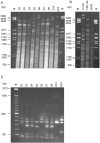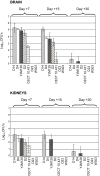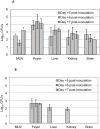Pathogenic potential of Saccharomyces strains isolated from dietary supplements
- PMID: 24879417
- PMCID: PMC4039445
- DOI: 10.1371/journal.pone.0098094
Pathogenic potential of Saccharomyces strains isolated from dietary supplements
Abstract
Saccharomyces cerevisiae plays a beneficial role in health because of its intrinsic nutritional value and bio-functional properties, which is why it is also used as a dietary supplement. However, the perception that S. cerevisiae is harmless has changed due to an increasing number of infections caused by this yeast. Given this scenario, we have tested whether viable strains contained in dietary supplements displayed virulence-associated phenotypic traits that could contribute to virulence in humans. We have also performed an in vivo study of the pathogenic potential of these strains using a murine model of systemic infection by intravenous inoculation. A total of 5 strains were isolated from 22 commercial products and tested. Results highlight one strain (D14) in terms of burden levels in brains and kidneys and ability to cause death, whereas the other two strains (D2 and D4) were considered of low virulence. Our results suggest a strong relationship between some of the virulence-associated phenotypic traits (ability to grow at 39°C and pseudohyphal growth) and the in vivo virulence in a mouse model of intravenous inoculation for isolates under study. The isolate displaying greatest virulence (D14) was evaluated in an experimental murine model of gastrointestinal infection with immunosuppression and disruption of mucosal integrity, which are common risk factors for developing infection in humans, and results were compared with an avirulent strain (D23). We showed that D14 was able to spread to mesenteric nodes and distant organs under these conditions. Given the widespread consumption of dietary supplements, we recommend only safe strains be used.
Conflict of interest statement
Figures












Similar articles
-
In vivo virulence of commercial Saccharomyces cerevisiae strains with pathogenicity-associated phenotypical traits.Int J Food Microbiol. 2011 Jan 5;144(3):393-9. doi: 10.1016/j.ijfoodmicro.2010.10.025. Epub 2010 Oct 28. Int J Food Microbiol. 2011. PMID: 21081253
-
Saccharomyces cerevisiae virulence phenotype as determined with CD-1 mice is associated with the ability to grow at 42 degrees C and form pseudohyphae.Infect Immun. 1994 Dec;62(12):5447-55. doi: 10.1128/iai.62.12.5447-5455.1994. Infect Immun. 1994. PMID: 7960125 Free PMC article.
-
Comparative genomic analysis reveals a critical role of de novo nucleotide biosynthesis for Saccharomyces cerevisiae virulence.PLoS One. 2015 Mar 27;10(3):e0122382. doi: 10.1371/journal.pone.0122382. eCollection 2015. PLoS One. 2015. PMID: 25816288 Free PMC article.
-
Review of current methods for characterizing virulence and pathogenicity potential of industrial Saccharomyces cerevisiae strains towards humans.FEMS Yeast Res. 2015 Sep;15(6):fov057. doi: 10.1093/femsyr/fov057. Epub 2015 Jul 19. FEMS Yeast Res. 2015. PMID: 26195617 Review.
-
Signal transduction cascades regulating pseudohyphal differentiation of Saccharomyces cerevisiae.Curr Opin Microbiol. 2000 Dec;3(6):567-72. doi: 10.1016/s1369-5274(00)00142-9. Curr Opin Microbiol. 2000. PMID: 11121775 Review.
Cited by
-
Scientific Opinion on the update of the list of QPS-recommended biological agents intentionally added to food or feed as notified to EFSA.EFSA J. 2017 Mar 14;15(3):e04664. doi: 10.2903/j.efsa.2017.4664. eCollection 2017 Mar. EFSA J. 2017. PMID: 32625421 Free PMC article.
-
Comparative genomics of infective Saccharomyces cerevisiae strains reveals their food origin.Sci Rep. 2023 Jun 27;13(1):10435. doi: 10.1038/s41598-023-36857-z. Sci Rep. 2023. PMID: 37369738 Free PMC article.
-
Genome-Wide Screen for Saccharomyces cerevisiae Genes Contributing to Opportunistic Pathogenicity in an Invertebrate Model Host.G3 (Bethesda). 2018 Jan 4;8(1):63-78. doi: 10.1534/g3.117.300245. G3 (Bethesda). 2018. PMID: 29122853 Free PMC article.
-
Opportunistic Strains of Saccharomyces cerevisiae: A Potential Risk Sold in Food Products.Front Microbiol. 2016 Jan 8;6:1522. doi: 10.3389/fmicb.2015.01522. eCollection 2015. Front Microbiol. 2016. PMID: 26779173 Free PMC article. Review.
-
Modulation of yeast Erg1 expression and terbinafine susceptibility by iron bioavailability.Microb Biotechnol. 2022 Nov;15(11):2705-2716. doi: 10.1111/1751-7915.14102. Epub 2022 Jul 15. Microb Biotechnol. 2022. PMID: 35837730 Free PMC article.
References
-
- Moyad MA (2007) Brewer's/baker's yeast (Saccharomyces cerevisiae) and preventive medicine: Part I. Urol Nurs. 27: 560–561. - PubMed
-
- Li YC (1994) Effects of brewer's yeast on glucose tolerance and serum lipids in Chinese adults. Biol Trace Elem Res 41: 341–347. - PubMed
-
- Reddy BS, Hirose Y, Lubet RA, Steele VE, Kelloff GJ, et al. (2000) Lack of chemopreventive efficacy of DL-selenomethionine in colon carcinogenesis. Int J Mol Med 5: 327–330. - PubMed
-
- Nakamura T, Agata K, Mizutani M, Lino H (2001) Effects of brewer's yeast cell wall on constipation and defecation in experimentally constipated rats. Biosci Biotechnol Biochem 65: 774–780. - PubMed
-
- Bahijiri SM, Mira SA, Mufti AM, Ajabnoor MA (2000) The effects of inorganic chromium and brewer's yeast supplementation on glucose tolerance, serum lipids and drug dosage in individuals with type 2 diabetes. Saudi Med J 21: 831–837. - PubMed
Publication types
MeSH terms
Substances
LinkOut - more resources
Full Text Sources
Other Literature Sources
Medical

